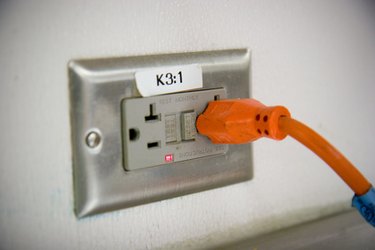Things You'll Need
Circuit breaker
3-wire electrical cable
Wire strippers
Screwdriver
Outlet

The vast majority of residential electrical circuits are only 110 volts because most small appliances, home electronics and light fixtures only require 110 volts to operate. However, larger appliances, work shop tools and other power hungry devices will need a higher voltage circuit to operate, which means that instead of only one “hot” wire, you will need two hot wires in addition to the white neutral and bare copper ground wire.
Step 1
Determine how many amps you need for your circuit. The appliance you want to plug in will have the required amperage in the instructions. Many high voltage circuits use 30 amps.
Video of the Day
Step 2
Buy a breaker rated for the amps you determined in step 1. Buy an appropriate cable for the amperage. See the Great Inspector link in the resource section for a chart of amperage versus wire gauge. Remember to buy 3-wire cable, instead of the standard 2-wire.
Step 3
Run the cable you bought from the breaker panel to the outlet box into which you want to install the plug.
Step 4
Remove the first 6 inches or so of the jacket to separate the wires and strip the wires about 1/2 inch to expose the bare copper.
Step 5
Feed the black and red wires into the terminal blocks labeled “hot” in the back of the 30 amp outlet. Do the same for the white wire into the neutral block and the bare copper ground wire into the ground block. Tighten the screws on each block to secure the wires in place.
Step 6
Screw the outlet to the outlet box using the supplied screws.
Step 7
Turn off the power to your breaker panel by flipping the main switch to your home.
Step 8
Slide the breaker you bought in step 2 into an empty breaker slot in the panel. Firm pressure will be enough to set it in place.
Step 9
Slip the black and red wires from the cable you ran into both terminal blocks on the new breaker and tighten the terminal screws.
Step 10
Slip the white wire into the neutral bus bar and tighten that screw.
Step 11
Slip the bare copper wire into the ground bus bar and finally tighten that screw as well.
Step 12
Turn the power to your house back on to begin using your new high voltage outlet.
Warning
Be completely sure the power is off to your panel before working in it, or you risk electrocution and possible death.
Video of the Day